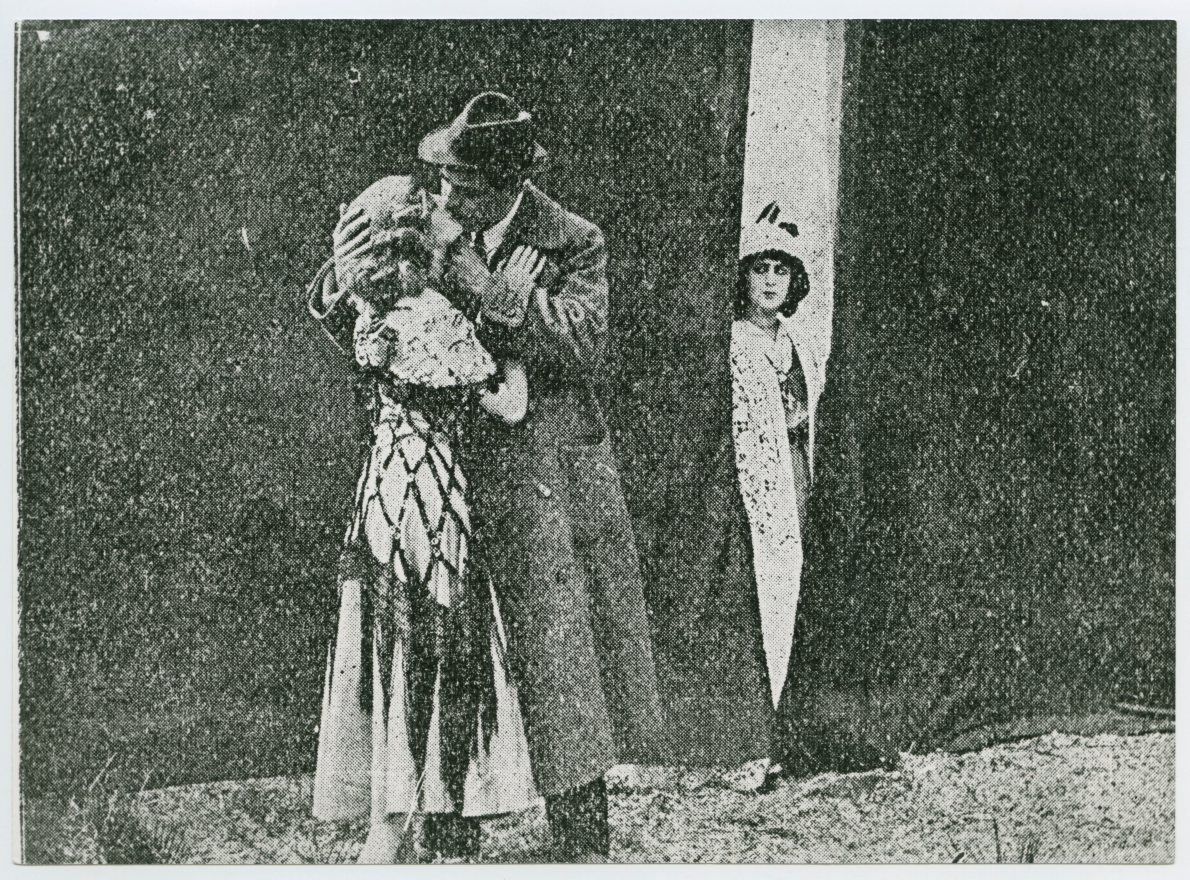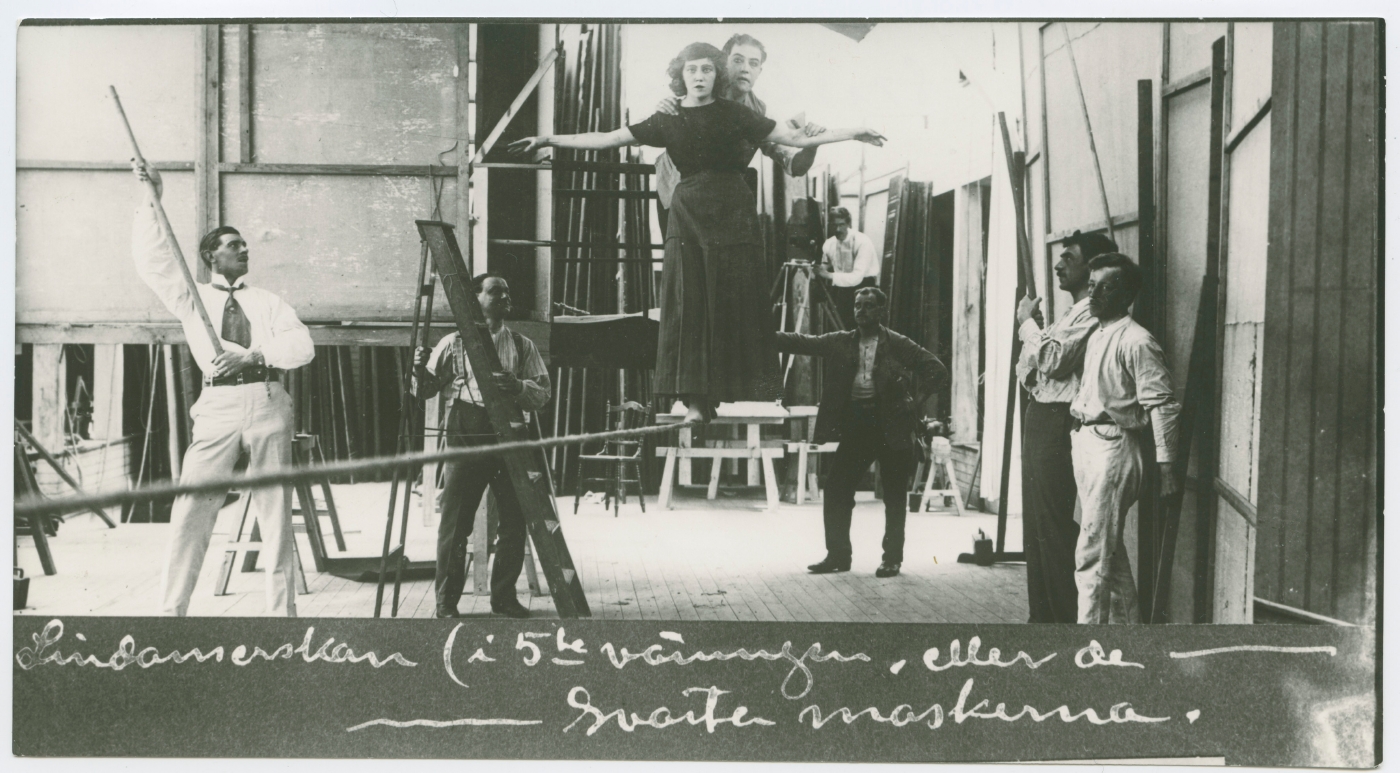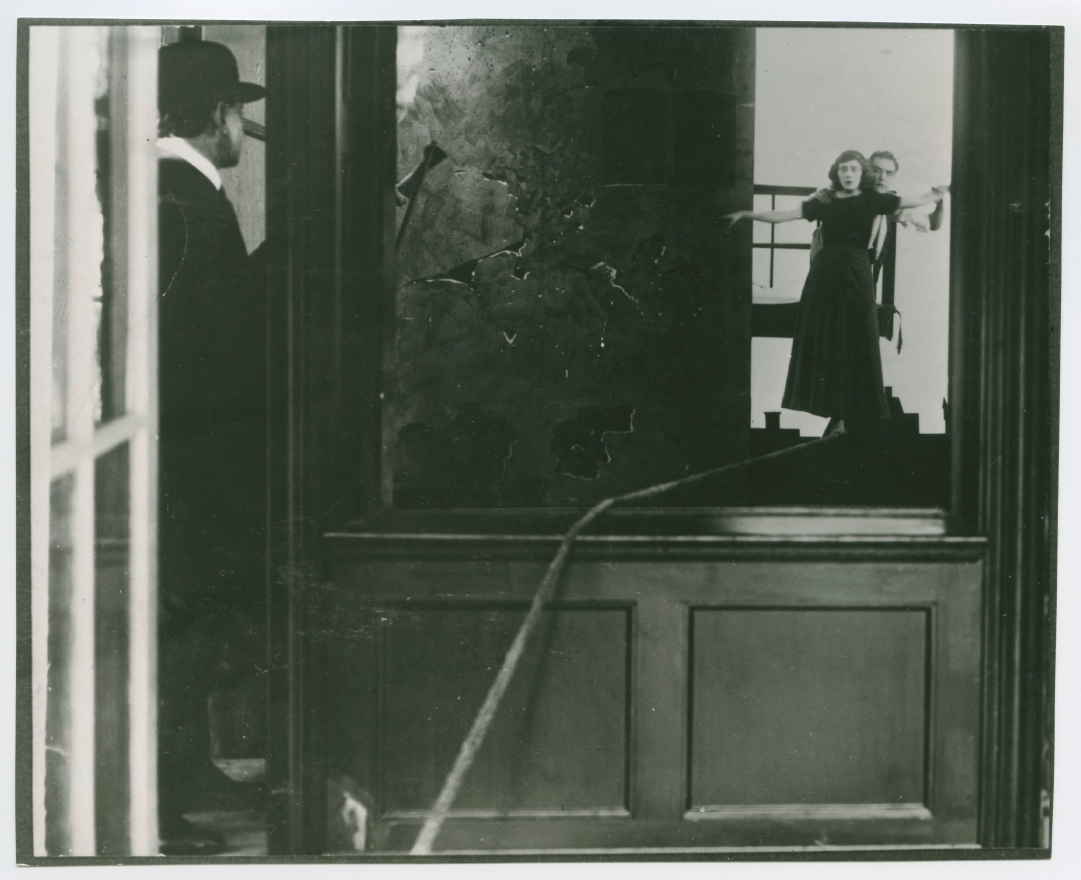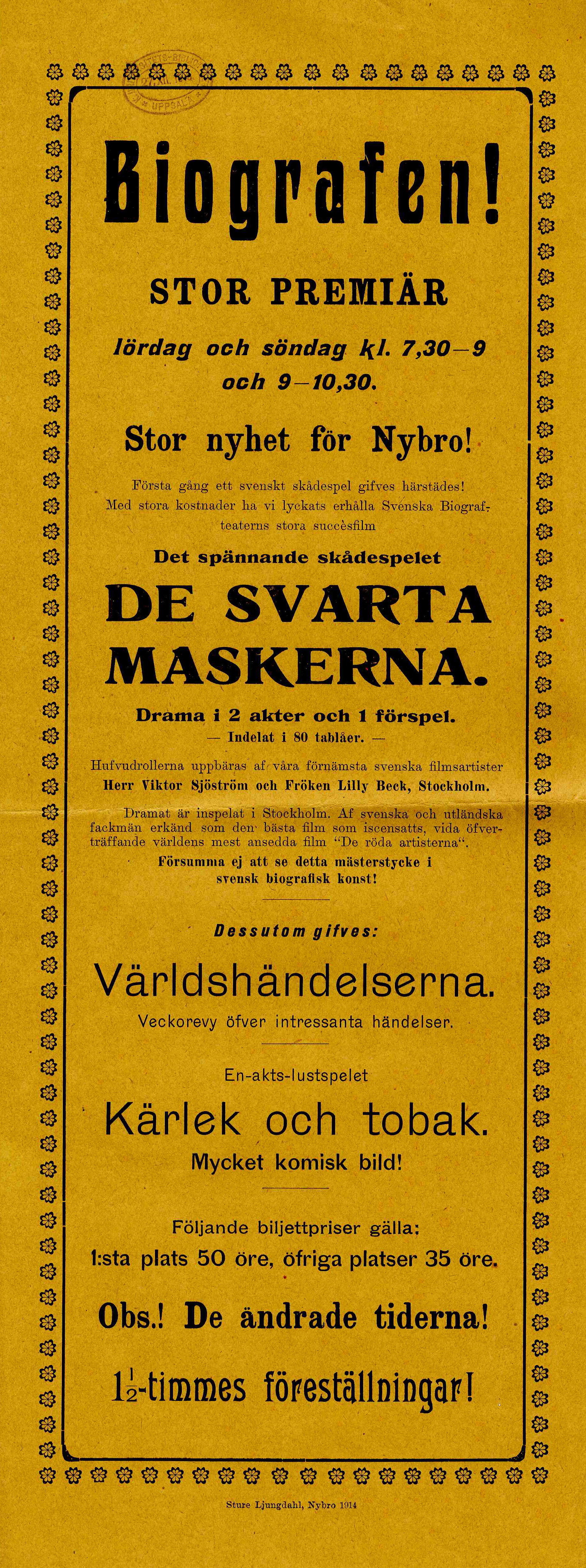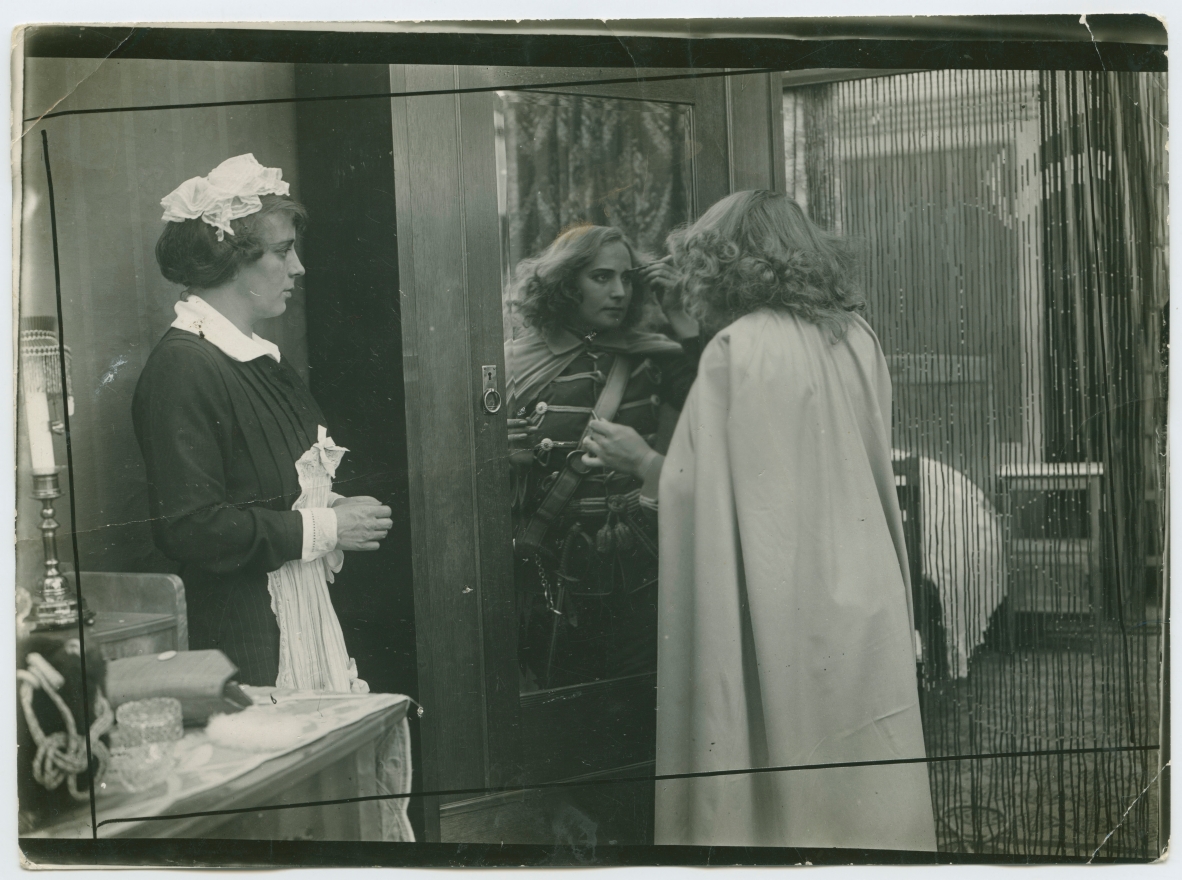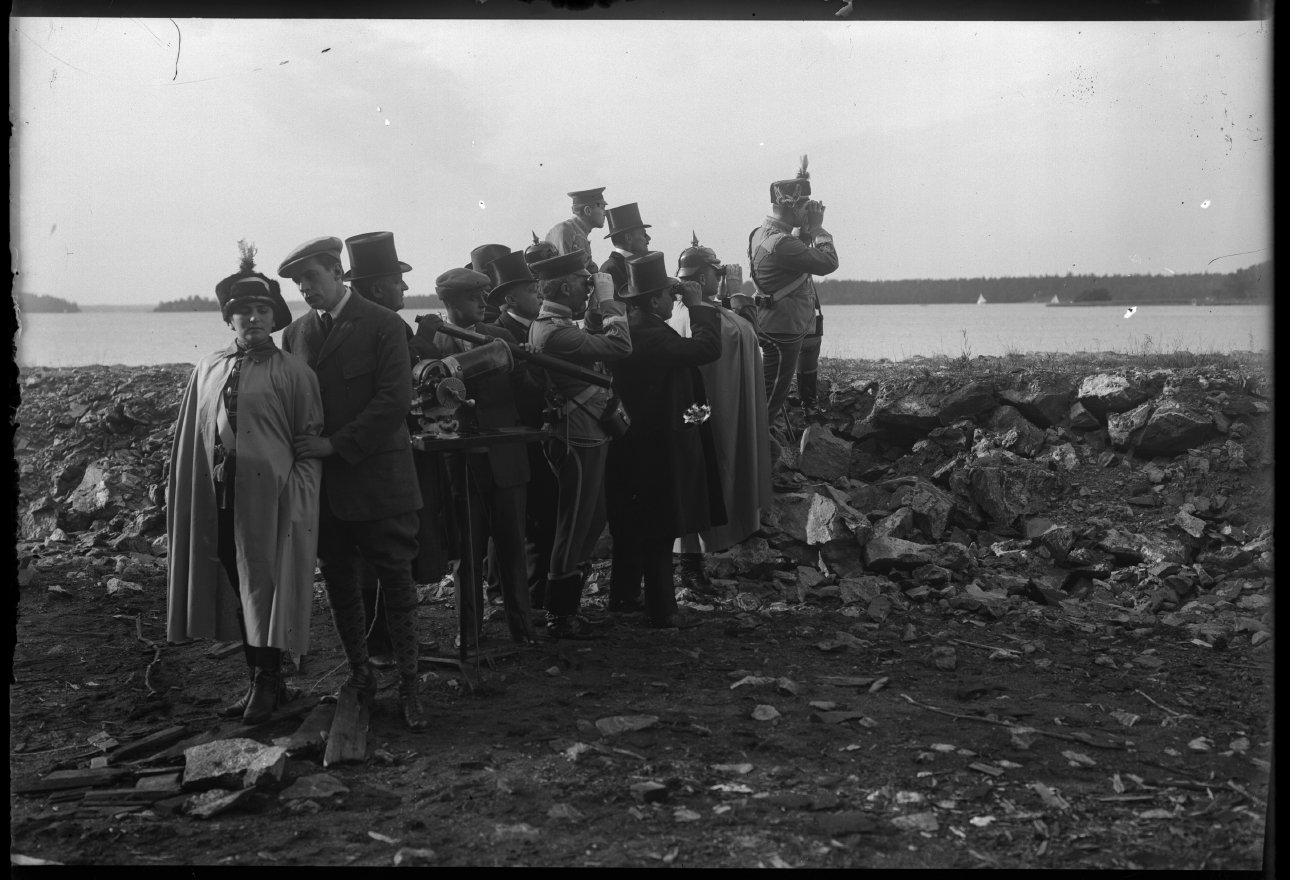Sigrid Calamnius arrived in Stockholm in 1895 and had several addresses around the borough of Östermalm, mainly round the Hedvig Eleonora parish. According to the population registration records of 1900, her home at the time was in the vicinity of Karlaplan, where – according to records provided via bibliographical notes of the Uppsala University Library – she created ”an artistic and literary gathering place for the so-called Karlaplan Gang, where among others [1931 Nobel prize laureate] Erik Axel Karlfeldt was a member”. Many years later, the milieu was described in the obituary for Calamnius’ son Folke Malmberg: ”a home where the great artists and cultural profiles of the turn of the century would check in on a daily basis” (Svenska Dagbladet, 20/3 1983). It is therefore hardly surprising that Sigrid Calamnius wrote three scripts for director Mauritz Stiller: Saved in Mid-Air (aka/lit. ”The Black Masks”) (De svarta maskerna, 1912), När kärleken dödar (”When Love Kills”, 1913) and Bröderna (”The Brothers”, 1914). Author/filmmaker and acclaimed Stiller scholar Gösta Werner writes that Stiller and Calamnius were part of the same social circles and that he employed her as his secretary. Through information obtained in Calamnius’ guest book, Werner deducts that Stiller was introduced to her by the couple Anna Norrie and her husband Anton de Verdier in June 1911. Among the findings it is documented that Calamnius and Stiller spent time in Visby in 1912 and worked on a script there, although it is unclear which script it concerns. The practical procedure is however quite clear: Stiller would orally present the script as an idea, that Calamnius would then write down. Calamnius also wrote a script on her own, titled ”Två viljor” (”Two Wills”), which was bought and optioned by the Svenska Bio company but never realised into a finished film.
Before entering the world of motion pictures, Calamnius had herself a sizeable career in music and singing. Her activities were covered in assorted local media, like in the Falu-Kuriren daily, where it is reported that ”Mrs Malmberg took part in the performance and she sang Swedish and French romantic pieces in a winsome fashion” (Falu Kuriren, 23/10 1907). In Calamnius’ 1947 obituary in Dagens Nyheter when she passed away at the age of 81, there is mention of the fact that she ”in her youth studied song and music abroad and performed recitals both in Sweden and in other countries” (DN, 18/4 1947). Records at the Roteman archives at The Swedish National Archives state that Calamnius was married on July 5th 1895 to Ernst Fredrik Waldemar Malmberg. In 1910 the population registration notes that Ernest had his address in Paris while Sigrid together with the couple’s three children, Curt Fredrik (born 1896), Folke (born 1898) and Sonja (born 1898), resided on Sturegatan in Östermalm in Stockholm. According to the population registration of 1930, the marriage was dissolved in 1911. In 1915, Malmberg, at the time a former army captain, moved to Stockholm’s Old Town and after this to Knivsta south of Uppsala in 1918.
Of the three films, only a clip of around two minutes from När kärleken dödar is preserved today. The scripts for Saved in Mid-Air and Bröderna still exist and one can detect Calamnius ideas when it comes to portraying characters and settings. Through Calamnius’ marriage to lieutenant – later captain – Ernst Fredrik Waldemar Malmberg, there are military aspects in her scripts. The script for Bröderna starts off with the two brothers Paul and Georg Williams displaying a model of a military invention (exactly what is not specified in the script) together with prints of the same invention ”in front of a group of expert military people”. “The Minister of War is giving a ball” and the character Susanne disguises herself as an officer “with the help of her chambermaid” in order to be able to attend a demonstration of the ‘invention’ and obtain information for an ambassador. The attribution of these ideas as being Calamnius’ rather than Stiller’s is deducted from the fact that Stiller employed Calamnius as a “scriptwriter”, and furthermore that Stiller, according to Werner, after being drafted for Russian military service refused to appear and was seized by the Russian authorities. However, he managed to make an escape and returned to Stockholm. In other words, Stiller avoided the military service he was subject to as a Russian citizen, while Calamnius as a captain’s wife can be assumed to have a degree of familiarity with military life.
Calamnius’ own ideas can possibly also be detected in the script for När kärleken dödar, in the storyline concerning the young artist Irma, who is commissioned by a Count Bjälke to paint his portrait. The count falls in love with Irma but she does not want to commit herself – rather, she wants to “go out into the world” and “make her way”. However, she does not succeed as an artist and through the twists of fate she is forced to marry the count in order to save the man she really loves. While Stiller was never married, Calamnius’ certainly was, at least around the time of the film’s release. Additionally, before this marriage, another engagement announcement is found in the newspapers – between Sigrid Calamnius and one count Arwid Posse of the Dragon corps (Aftonbladet, 21/5 1890). Any source of a marriage actually taking place is not to be found and the following year an engagement announcement instead appears, between Count Posse and one Ottilia Wienna Thestrup, who married in 1891, according to information from the Roteman archives. As we know, Sigrid Calamnius married Ernst Malmberg instead. While it may not directly be possible to regard these events as an inspiration for När kärleken dödar, it is an interesting parallel.
Bio Rama, “Malmö’s Most Modern Cinematographic Theatre”, wrote in its program sheet; “Saved in Mid-Air. The world’s greatest sensational motion picture.” The leaflet also describes the plot of the film, in which the tightrope dancer Lola leaves “her beloved”, von Muhlen, in order to “take on a new assignment”. One year later, von Muhlen, who had joined a secret society, is “commissioned to bring important documents to another section of the society.” Spies, operating under the moniker “The Black Masks”, send the “most beautiful and also the most cunning female member Lydia” to get her hands on the important documents. It so happens that von Muhlen takes Lydia to a circus performance, where Lola happens to be a tightrope dancer. von Muhlen and Lola share a kiss after the performance, an act that Lydia happens to catch, and Lydia now decides to complete the mission instead of aborting it, as was her original plan. von Muhlen is captured by The Black Masks, but is rescued by Lola and her high wire act. In the original script, the “secret society” is a political party, Lydia is called Adele and von Muhlen is described as “the lieutenant”. However, the message Lola sends with the words “I shall save you” is included in both versions. Calamnius’ script contribution, which to some extent gets lost in the program sheet description, makes itself reminded in such details as the Muhlen character being a lieutenant. Werner also writes, in his book Mauritz Stiller och hans filmer (“Mauritz Stiller and his films”) about Saved in Mid-Air that, according to Finnish historian and Stiller’s close friend Alma Söderhjelm, “Sigrid Calamnius was the more or less anonymous co-author of Stiller of unnamed films, which are said to have premiered in the autumn of 1912 – including as a screenwriter for Saved in Mid-Air“. Werner states that he has the greatest confidence in these details and that his conclusion is that Calamnius and Stiller “together designed the film’s original script.”
From 1914, Mauritz Stiller will choose to collaborate with the actor Ester Julin on matters concerning screenplays. Calamnius will relocate from Katarina parish in Stockholm to Uppsala in 1922. She will pass away on April 6, 1947 in Engelbrekt’s parish in Stockholm.
Rosann Fried (2020)
(translated by Jan Lumholdt)
Källor:
Aftonbladet, ”Förlovning”, 21/5 1890.
Alvin-portal, kontrollerad 7/5 2020, http://www.alvin-portal.org/alvin/view.jsf?pid=alvin-record%3A8346&dswid=9600.
Dagens Nyheter, ”Sigrid Calamnius”, Dödsfall, 18/4 1947, 6.
Danderyds kyrkoarkiv, Församlingsböcker. Bunden serie, SE/SSA/1494/A II a/9 (1916–1928).
Falu-Kuriren, ”Mudoool-Edwarskonserten”, 23/10 1907.
Riksarkivet: Ernst Fredrik Malmberg; Sigrid Malmberg; Dödregistret, Post-ID: SDB7_08906490.
Riksarkivet, Rotemanarkivet, PostID: 002580040100.
Riksarkivet, Rotemanarkivet, PostID: 002750030090.
Riksarkivet, Rotemanarkivet, PostID: 071320120030.
Riksarkivet, Rotemanarkivet, PostID: 120020150150.
Riksämbetsantikvariatet: http://www.bebyggelseregistret.raa.se/bbr2/byggnad/visaHistorik.raa?byggnadId=21420000011581&page=historik.
Svenska Dagbladet, ”Folke Malmberg”, 20/3 1983, 20.
Werner, Gösta. Mauritz Stiller och hans filmer. Stockholm: Kungl Boktryckeriet P A Nordstedt & Söner, 1971.
Werner, Gösta. Mauritz Stiller – Ett livsöde. Stockholm: Prisma, 1991.
Basic info
Main profession: Screenwriter
Born: 1866
Died: 1947
Active: 1912-1914
Filmography
Manus:
Bröderna (1914)
När kärleken dödar (1913)
De svarta maskerna (1912)


